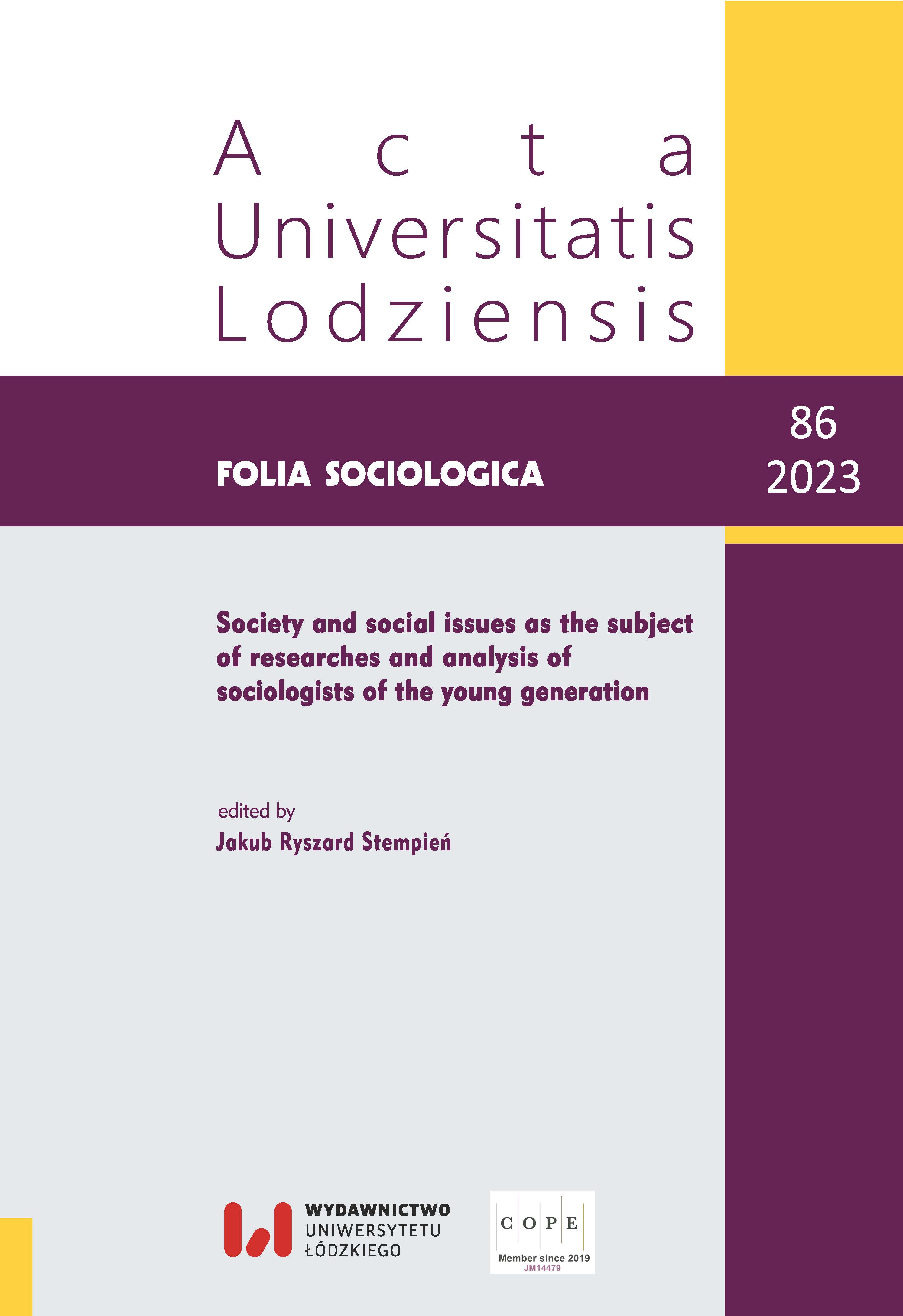Immersive virtual reality as a social research environment. The impact of the presence of an embodied agent on the Stroop task performance based on own research
DOI:
https://doi.org/10.18778/0208-600X.86.01Keywords:
Virtual reality, VR, immersive virtual reality, social facilitation, social inhibition, Stroop task, Stroop interference, embodied agent, social researchAbstract
This empirical study examined the effects of the presence of others (physical observers and embodied agents) on the performance of the Stroop task within an immersive virtual reality (VR) environment. Drawing from the research conducted by Pascal Huguet and his colleagues, who explored the social facilitation and inhibition effects in traditional lab conditions using the Stroop test, the current study sought to test these effects in VR conditions. Participants were divided into four groups, each experiencing different conditions – performing the task alone, under the awareness of being observed, or in the presence of embodied agents (formally dressed as Dr. Piotr or casually as Piotrek). A one-way analysis of variance (ANOVA) for independent samples was conducted to evaluate the results. Findings showed a significant reduction in Stroop interference when participants were aware of being observed by the experimenter. However, the presence of embodied agents in the VR environment, regardless of their regardless of their dress or manner of presentation, did not significantly influence the results. These results not only confirmed the occurrence of the Stroop interference effect in VR conditions, comparable to traditional lab conditions, but they also suggested that the social presence of the experimenter could enhance task performance in the VR environment. There was no significant influence observed from the presence of embodied agents, though. These observations can greatly contribute to the development of VR. However, further research is required to expand these findings, considering factors such as sample size and realism of embodied agents.
References
Baños R.M., Botella C., Perpiñá C. (1999), Virtual reality and psychopathology, “Cyberpsychology & Behavior”, vol. 2(4), pp. 283–292.
Google Scholar
Baron R.S. (1986), Distraction-conflict theory: Progress and problems, [in:] L. Berkowitz (ed.), Advances in experimental social psychology, Academic Press, New York.
Google Scholar
Biocca F. (1997), The cyborg’s dilemma: progressive embodiment in virtual environments, “Journal of Computer-Mediated Communication”, 3:JCMC324, https://doi.org/10.1111/j.1083-6101.1997.tb00070.x (accessed: 17.08.2022).
Google Scholar
Bond C.F. Jr. (1982), Social facilitation: A self-presentational view, “Journal of Personality and Social Psychology”, vol. 42(6), pp. 1042–1050.
Google Scholar
Bond C.F. Jr., Titus L.J. (1983), Social facilitation: A metanalysis of 241 studies, “Psychological Bulletin”, vol. 94(2), pp. 265–292.
Google Scholar
Botella C., Baños R.M., Garcia-Palacios A., Quero S. (2017), Virtual Reality and Other Realities, [in:] S.G. Hofmann, G. Asmundson (eds.), The science of cognitive behavioral therapy, Boston.
Google Scholar
Brzezinska A. (2020), Od mediów do rzeczywistości. Jakie ryzyka i szanse niesie ze sobą popularyzacja VR?, Fundacja Centrum Cyfrowe, Warszawa.
Google Scholar
Cottrell N.B. (1972), Social facilitation, [in:] C.G. McClintock (ed.), Experimental social psychology, Holt, Rinehart & Winston, New York.
Google Scholar
Frankfort-Nachmias C., Nachmias D. (2001) Metody badawcze w naukach społecznych, Zysk i S-ka, Poznań.
Google Scholar
Freeman D., Pugh K., Vorontsova N. (2010), Testing the Continuum of Delusional Beliefs: An Experimental Study Using Virtual Reality, “Journal of Abnormal Psychology”, vol. 1, pp. 83–89.
Google Scholar
Grzeszkiewicz-Radulska K., Wiktorowicz J., Grzelak M.M. (2020), Analiza statystyczna z IBM SPSS Statistics, Wydawnictwo Uniwersytetu Łódzkiego, Łódź.
Google Scholar
Huguet P., Galvaing M.P., Jean M., Monteil J.M., Dumas F. (1999), Social Presence Effects in the Stroop Task: Further Evidence for an Attentional View of Social Facilitation, “Journal of Personality and Social Psychology”, vol. 77(5), pp. 1011–1025.
Google Scholar
Milgram P., Kishino F. (1994), A Taxonomy Of Mixed Reality Visual Displays, “IEICE Transactions on Information Systems”, vol. E77-D, no. 12, December.
Google Scholar
Okruszek E., Rutkowska A. (2013), Badanie kontroli wykonawczej za pomocą testu interferencji strupa u chorych na schizofrenię i osób z uszkodzeniami płatów czołowych, “Polskie Forum Psychologiczne”, vol. 18, no. 2.
Google Scholar
Slater M., Antley A., Davison A,. Swapp D., Guger C., Barker Ch., Pistrang N., Sanchez-Vives M.V. (2006), A Virtual Reprise of the Stanley Milgram Obedience Experiments, “PLOS ONE”, vol. 1(1): e39, https://doi.org/10.1371/journal.pone.0000039
Google Scholar
Smelser N. (1995), Social science: an imperfect art, “La Revue Tocqueville”, vol. 16, no. 1, pp. 3–24.
Google Scholar
Sosnowski T., (2004), Analiza kontrastów: między eksploracją a testowaniem hipotez, “Przegląd Psychologiczny”, vol. 47, no. 4.
Google Scholar
Śpiewak S, (1999), Wpływ bodźców supra i subliminalnych na efekt interferencji w zadaniu Stroopa, “Czasopisma Psychologiczne”, vol. 5, no. 2, pp. 129–139.
Google Scholar
Tomaszewska M., Markowska, A., Borkowska A. (2010), Test Stroopa – wartość diagnostyczna w psychiatrii, “Neuropsychiatria i Neuropsychologia”, vol. 5, no. 1, pp. 35–41.
Google Scholar
Triplett N. (1898), The Dynamogenic Factors in Pacemaking and Competition, “The American Journal of Psychology”, vol. 9(4), pp. 507–533.
Google Scholar
Vakil E., Manovivh R., Ramati E., Blachstein H. (1996), The Stroop Color-Word Task as a Measure of Selective Attension: Efficiency, “Developmental Neuropsychology”, vol. 12(3), pp. 313–315.
Google Scholar
Wojciszke B. (2002), Człowiek wśród ludzi. Zarys psychologii społecznej, Wydawnictwo Naukowe Scholar, Warszawa.
Google Scholar
Zajonc R.B. (1965), Socjal Facilitation, “Science, New Series”, vol. 149, no. 3681, pp. 269–274.
Google Scholar
Published
Versions
- 2024-01-15 (2)
- 2023-09-30 (1)
How to Cite
Issue
Section
License

This work is licensed under a Creative Commons Attribution-NonCommercial-NoDerivatives 4.0 International License.










